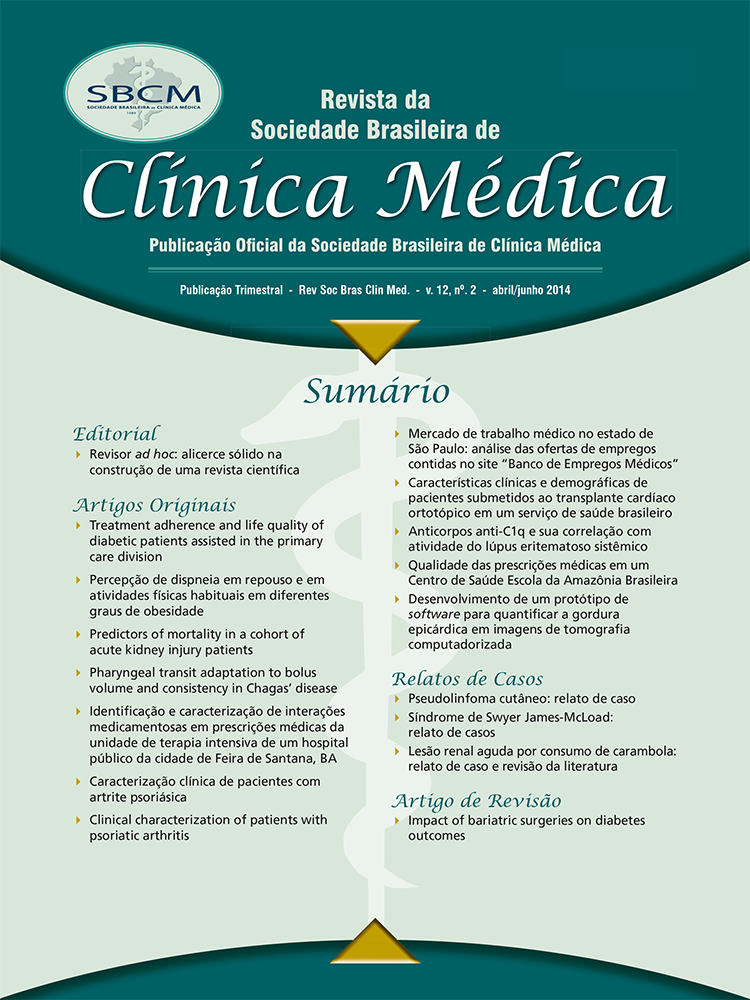Impact of bariatric surgeries on diabetes outcomes
Main Article Content
Resumo
Obesity and type 2-diabetes (T2D) are associated to dramatically high morbidity and mortality, and their incidence and prevalence are increasing rapidly. Bariatric surgeries, including a variety of gastrointestinal surgical procedures achieve substantial and sustained weight loss in morbidly obese patients, strongly improves diabetes and hypertension control or prevalence, quality of life, decreases incidence of stroke, myocardial infarction and obstructive sleep apnea among other favorable clinical outcomes. Most important, mortality rates decreases. The objectives of this narrative review were the effectiveness of bariatric procedures on diabetes remission or improvement and the implicated mechanisms. It was found that bariatric surgeries induce high rates of short and long-term diabetes remission (from 60 to 95% or improved control), according to the surgical intervention, with low frequency of perioperative and postoperative complications. Rates of diabetes recurrence are not well known, but the time free-of-disease should ameliorate diabetes complications and mortality. The mechanisms are still not completely understood; encompass improved insulin action, better b-cell function, higher adiponectin, lower inflammation and complex changes of hormones of the entero-insular axis, GLP-1 and glucose dependent insulinotropic polypeptide (GIP). Insulin action improves proportionally to weight loss (WL), in most types of surgery, but normalizes after Bilio-pancreatic diversion even in still obese people. b-cell function improves more after bypass than after restrictive surgeries, but does not normalize and baseline function predicts diabetes remission. Efforts to understand mechanisms and predictive factors for diabetes remission may optimize surgical interventions for metabolic disorders even in less obese patients. Finally and more important, they might drive the development of new clinical approaches for T2D.
Article Details
Declaração de Direito Autoral
Eu (nome do autor responsável) _______________________________________________ declaro que o presente artigo intitulado ___________________________________é original, não tendo sido submetido à publicação em qualquer outro periódico nacional ou internacional, quer seja em parte ou em sua totalidade. Declaro, ainda, que uma vez publicado na revista Revista da Sociedade Brasileira de Clinica Médica, editada pela Sociedade Brasileira de Clínica Médica, o mesmo jamais será submetido por um dos demais co-autores a qualquer outro meio de divulgação científica impressa ou eletrônica.
Por meio deste instrumento, em meu nome e dos demais co-autores, cedo os direitos autorais do referido artigo à Revista da Sociedade Brasileira de Clinica Médica, e declaro estar ciente de que a não observância deste compromisso submeterá o infrator a sanções e penas previstas na Lei de Proteção de Direitos Autorias (n 9610 19 de fevereiro de 1998) que altera, atualiza e consolida a legislação sobre direitos autorais e dá outras providências. Disponível em: http://www.planalto.gov.br/ccivil_03/leis/l9610.htm
|
_________________________ |
___________________ |
|
Local, data |
Assinatura |
SOCIEDADE BRASILEIRA DE CLÍNICA MÉDICA
CNPJ/MF 062.279.617/0001-45
Rua Botucatu, nº 572, cj. 112, São Paulo, SP
Download da Declaração de Direito Autoral.
